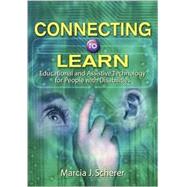Dr. Scherer, author of the highly acclaimed Living in the State of Stuck: How Technology Impacts the Lives of People with Disabilities, explores the way disabilities, especially those involving the senses, can lead to isolation and a lack of "connectedness," and how this in turn leads to learning difficulties. She then provides a step-by-step model for assessing and evaluating individual students on their needs and finding the right technology to help each student.








